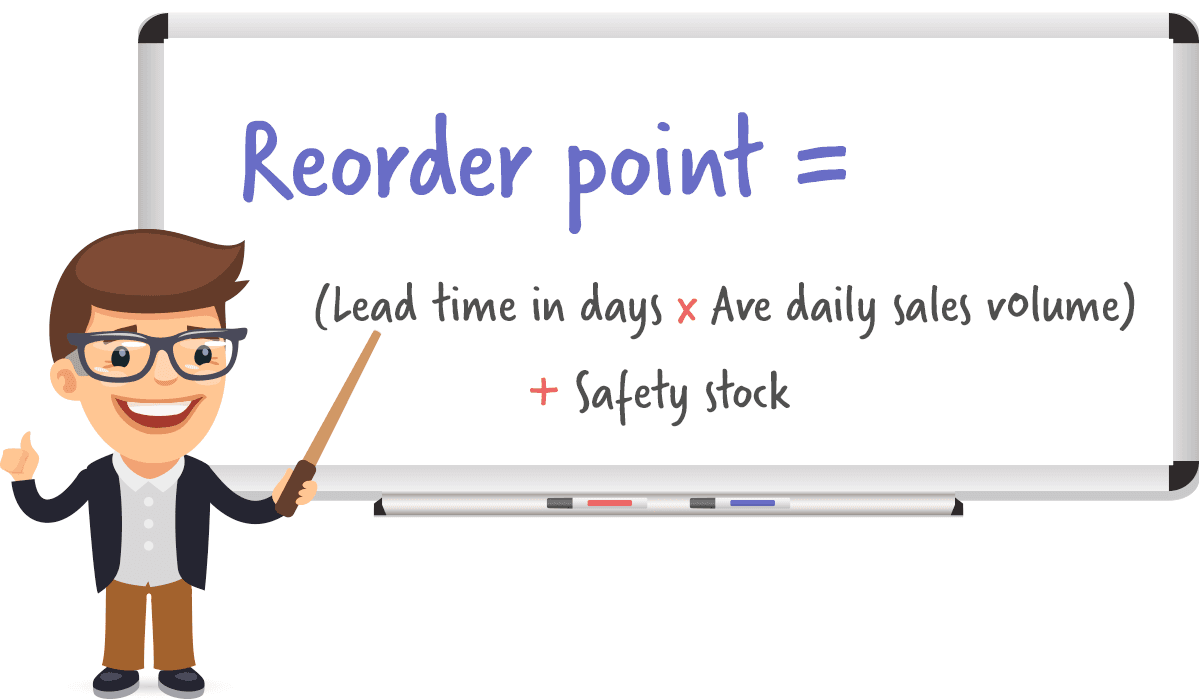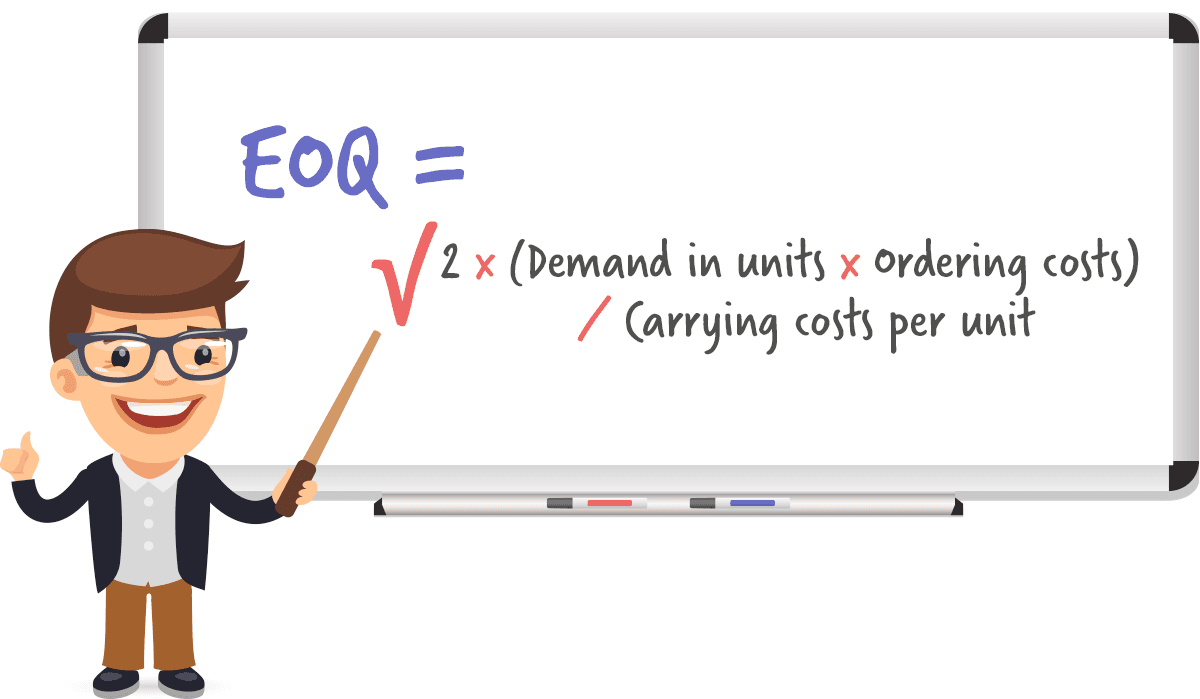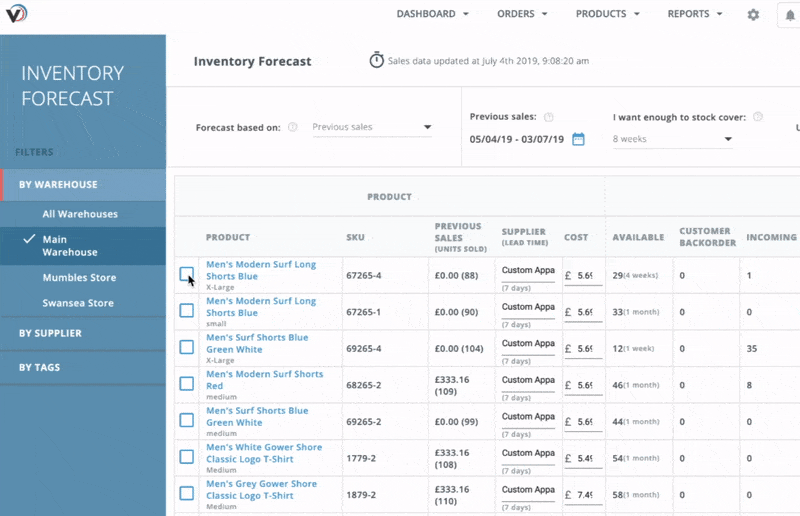Purchasing Inventory
Purchasing inventory is about more than just raising a purchase order. Serious businesses pay close attention to how much inventory they should order and exactly when to do it in order to minimise carrying costs and achieve steady growth.
This whole practice is, therefore, a critical aspect of effective inventory management. And something we discuss how to optimise in this chapter.
Methods of purchasing inventory
There are several methods you can use for purchasing inventory. Each one has its own benefits and drawbacks, and so what might work for one business may not for another.
1) Bulk buying
Also referred to as ‘just-in-case’ inventory purchasing, this is where a company would buy its inventory in bulk batches. Stock will then be held at a warehouse, third-party logistics (3PL) facility or location of some kind in order to supply a forecasted demand.
Bulk buying is perhaps the most well-known way of purchasing inventory. It could involve purchasing finished products or raw materials in a vast array of quantities – depending on what’s best for a business at that particular time.
Pros:
Take advantage of bulk buying discounts.
Potential for greater profit margins due to smaller cost-per-unit.
Relatively simple purchasing system to set up.
Cons:
Costs associated with a warehouse or 3PL partner for inventory storage.
Risk of sinking cash into too much stock if forecasting is inaccurate.
Best for: Growing or established businesses that have a good handle on expected demand and profit margins.
2) Dropshipping
Dropshipping is a method of purchasing inventory where the retailer doesn’t keep any of the products it sells in stock.
Instead, items are purchased from a third-party supplier as and when each customer order comes in, with the supplier shipping products directly to the customer.
As a result, the retailer usually doesn’t ever see, handle, stock or own any of the inventory themselves. This method may sound appealing, but it does have several drawbacks too.
Pros:
Effectively removes the need for any inventory management by the retailer.
Removes risk of cash getting tied up in inventory that doesn’t sell.
Lower overall costs of not needing a warehouse, 3PL or fulfilment team.
Easy to find, source and test new products.
Cons:
Profit margins can be thin from lack of bulk buy savings.
Little to no control over fulfilment speed and product/package branding.
Products are easily accessible to other dropshippers, meaning you’ll likely be facing stiff competition.
Best for: Startup retail brands, or more established brands wanting to test the waters for a new product without investing in lots of inventory.
3) Just-in-time (JIT)
Just-in-time (JIT) is usually better associated with retailers that manufacture their own products. This would involve ordering raw materials and assembling each product as and when an order comes in – hence, it’s produced ‘just-in-time’ for fulfilment.
This method can result in holding much less ‘on-hand’ inventory, but requires seamless management of the manufacturing process and a highly reliable supply chain.
Pros:
Reduced warehouse costs from needing to store on-hand inventory and materials.
Maintain control of your product quality and branding.
Less waste of raw materials.
Cons:
Any supply chain hiccup can have large effects on production.
Supply chain lead times will need to be factored into overall order fulfilment speed.
Requires highly sophisticated management and processes to get right.
Best for: Larger businesses manufacturing their own products with sophisticated production processes in place. These businesses will also tend to rely on fewer orders that contain many quantity units in each one.

When to order new inventory
Dropshipping and JIT speak for themselves when it comes to placing a new purchase order – you do it as and when each sales order comes in.
But most growing retailers will most likely be going down the bulk buying route. And this begs the question, when’s the right time to place a new bulk buy order?
There are three methods to use:
1. Order pattern method
This would involve simply making regular fixed purchases of the same amount. It’s perfect for retailers who know they’re sales numbers will rarely change, with a review taking place maybe 1-2 times a year.
2. Control rhythm method
This would involve checking inventory at fixed intervals and purchasing inventory amounts that have been adjusted accordingly. It’s perfect for retailers that have a good grasp of their demand and inventory forecasting.
3. Reorder point method
This involves reordering stock once it gets below a certain level, usually set via a calculation. It tends to work better for retailers with fewer products, and who aren’t reliant on bulk buying discounts from large purchase orders of multiple products at a time.
Determining which method to use depends completely on how your business operates.
For example:
Order pattern method could be catastrophic if you have products that are highly seasonal or fluctuate in sales.
But the reorder point method might not make sense if smaller, more regular purchase orders means you’d miss out on significant bulk buying discounts.
Calculating reorder point
Purchasing inventory based on reorder points is a very common method to use.
In essence, an item’s reorder point needs to be as soon as its safety stock levels are hit.
But we also need to make sure we don’t run out of stock in the time it takes for our new inventory to be delivered. So the lead time between ordering and receiving the order needs to be taken into account.
Here’s the formula to use:

For example:
Imagine we typically sell 11 blue t-shirts each day. If we aim to always keep 50 in safety stock, and it usually takes seven days to receive and put away new inventory – then reorder point would look like this:
Reorder point = (7 x 11) + 50
Reorder point = 77 + 50
Reorder point = 127
So a new purchase order needs to be created for our blue t-shirts as soon as inventory levels hit 127 units.
How much new inventory to order
We’ve covered when the best time is to place a new purchase order. Next comes the question, how much stock is best to order at one time?
To answer this, there are several things to consider:
Forecasted demand.
Bulk buying discounts.
Carrying/storage costs.
Ordering costs.
One option is to manually take these into account with your thought process each time you go about purchasing inventory.
But we can also use a more scientific method known as economic order quantity (EOQ).
EOQ is a calculation that helps work out the most economical quantity of inventory to order for a specific product. The three variables involved are:
Demand. The number of units sold over a given time period (usually a year).
Relevant ordering cost. Total ordering cost per purchase order. This includes all staff, transportation and any other costs associated with making each purchase order – but not the actual cost of the order itself.
Relevant carrying cost. Assume the item is in stock for the entire time period in question and decipher the carrying cost per unit.
You’ll then put this into the following equation:

This helps determine the best amount of inventory to order each time. Helping strike a balance between minimal ordering and carrying costs, while still satisfying demand.
Automated inventory purchasing
Purchasing inventory is another task that can be brought into the digital world. This helps to automate a lot of the repetitive, manual tasks, while also taking care of some of the complicated forecasting and mathematics involved.
Veeqo, for example, allows you to:
Manage all your suppliers in one CRM-like database.
Manually add and remove products to digital purchase orders.
Auto-populate purchase orders with items low on stock and/or below re-order point.
Email the purchase order off to suppliers:

You can then manage all active purchase orders in one place to see when delivery is expected. And even send reminder emails to suppliers for any order that’s past due.
Common purchasing questions
Below are some frequently asked questions we typically see when it comes to inventory purchasing for retailers.
What is a purchase order?
A purchase order (commonly referred to by the initials PO) is a critical commercial document in the process of purchasing inventory. It effectively creates a new ‘order’ with a supplier, detailing all the items, quantities, and agreed prices for either ready for sale goods or raw materials to be used in manufacturing.
What are the methods of purchasing inventory?
The main methods of purchasing inventory would be:
Bulk buying.
Dropshipping.
Just-in-time (JIT)
We discuss these in greater detail in our dedicated section on purchasing methods here.
How do you calculate reorder point?
A reorder point can be set for each product or variant a company holds in its inventory. It is a specific point in time that acts as a trigger to re-order as soon as stock has diminished to that certain level.
It’s important to take into account the typical lead time between ordering and receiving a new delivery. This helps to ensure stockouts don’t occur while waiting for new stock, and also that safety stock levels aren’t eaten into.
Does Veeqo help with purchase orders?
Yes! Veeqo can help retailers to:
Manage all their suppliers in one database.
Create digital purchase orders and add any products.
Auto-populate POs with items low on stock and/or below reorder point.
Email POs off to suppliers.
Keep track of POs, update stock levels, and follow up on late deliveries.
You can see more about Veeqo’s inventory management features here.

In the previous two chapters of this guide, we’ve talked about how to plan, forecast and purchase new inventory.
The next chapter moves on to optimising your inventory storage procedures. We’ll cover how to book-in and look after your stock in order to have it ready for sale as soon as possible and minimise spoilage and shrinkage. You may also be interested in the best practices for stocktaking or learning more about inventory control.






